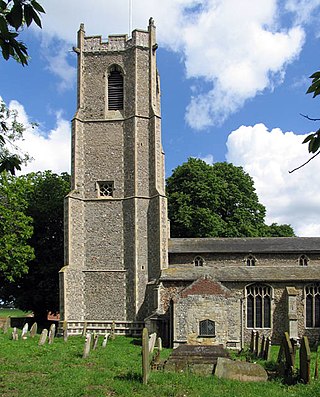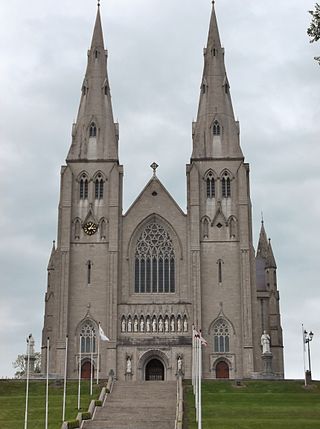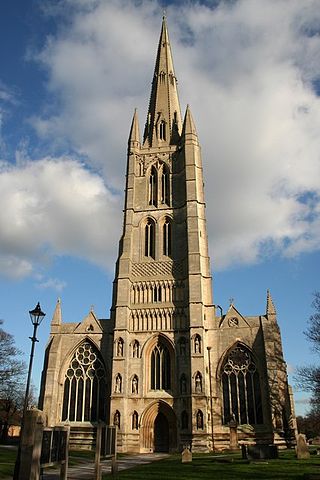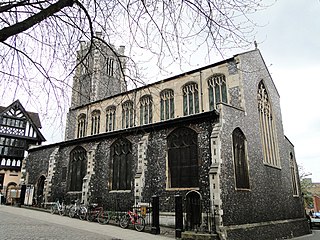
Barton Turf is a village and civil parish in the English county of Norfolk. It is 20 km north-east of the city of Norwich, on the northwestern edge of Barton Broad, the second largest of the Norfolk Broads. In primary local government the area is in the district of North Norfolk.

Wymondham Abbey is the Anglican parish church for the town of Wymondham in Norfolk, England.

The rood screen is a common feature in late medieval church architecture. It is typically an ornate partition between the chancel and nave, of more or less open tracery constructed of wood, stone, or wrought iron. The rood screen was originally surmounted by a rood loft carrying the Great Rood, a sculptural representation of the Crucifixion. In English, Scottish, and Welsh cathedrals, monastic, and collegiate churches, there were commonly two transverse screens, with a rood screen or rood beam located one bay west of the pulpitum screen, but this double arrangement nowhere survives complete, and accordingly the preserved pulpitum in such churches is sometimes referred to as a rood screen. At Wells Cathedral the medieval arrangement was restored in the 20th century, with the medieval strainer arch supporting a rood, placed in front of the pulpitum and organ.

St. Patrick's Cathedral in Armagh, Northern Ireland is the seat of the Catholic Archbishop of Armagh, Primate of All Ireland. It was built in various phases between 1840 and 1904 to serve as the Roman Catholic cathedral of the Archdiocese of Armagh, the original medieval Cathedral of St. Patrick having been retained by the state church, the Church of Ireland at the time of the split of the Irish Church during the Reformation.

Trunch is a village and parish in Norfolk, England, situated three miles north of North Walsham and two miles from the coast at Mundesley. At the Census 2011 the village had a population of 909. The parish covers an area of 5.5 square kilometres (2.1 sq mi).

Saint-Étienne-du-Mont is a church in Paris, France, on the Montagne Sainte-Geneviève in the 5th arrondissement, near the Panthéon. It contains the shrine of St. Geneviève, the patron saint of Paris. The church also contains the tombs of Blaise Pascal and Jean Racine. Jean-Paul Marat is buried in the church's cemetery.

St Cyprian's Church is a parish church of the Church of England in the Marylebone district of London. The church was consecrated in 1903, but the parish was founded in 1866. It is dedicated to Cyprian, a third-century martyr and bishop of Carthage and is near the Clarence Gate Gardens entrance to Regent's Park, off Baker Street. The present church was designed by Ninian Comper and is a Grade II* listed building.

St Wulfram's Church, Grantham, is the Anglican parish church of Grantham in Lincolnshire, England. The church is a Grade I listed building and has the second tallest spire in Lincolnshire after St James' Church, Louth.

The Church of St Helen, Ranworth, Norfolk is a church of medieval origins notable for its collection of church paintings. Known as "the Cathedral of The Broads", the church dates from the 14th century, although with origins in Saxon times. It contains a major collection of medieval artefacts, in particular the church's rood screen and the Ranworth Antiphoner, a liturgical manuscript.

St Mary's is an Anglican parish church in Elsing, a small village and civil parish in the Breckland district of Norfolk, England. The 14th-century church was built to a single plan in Decorated Gothic style by a local knight and has remained largely unaltered to the present day. The church contains a brass monument of national importance, a tall medieval font cover and rood screen paintings. The chancel retains some stained glass contemporary with the construction of the building.

The Church of St John the Baptist, Maddermarket, is a redundant Anglican church in the city of Norwich, Norfolk, England. It is recorded in the National Heritage List for England as a designated Grade I listed building, and is in the care of the Churches Conservation Trust.

St Denys' Church is a medieval Anglican parish church in Sleaford, Lincolnshire, England. While a church and a priest have probably been present in the settlement since approximately 1086, the oldest parts of the present building are the tower and spire, which date to the late 12th and early 13th centuries; the stone broach spire is one of the earliest examples of its kind in England. The Decorated Gothic nave, aisles and north transept were built in the 14th century. The church was altered in the 19th century: the north aisle was rebuilt by the local builders Kirk and Parry in 1853 and the tower and spire were largely rebuilt in 1884 after being struck by lightning. St Denys' remains an active parish church.

St Nicholas is the Anglican parish church of Blakeney, Norfolk, in the deanery of Holt and the Diocese of Norwich. The church was founded in the 13th century, but the greater part of the church dates from the 15th century when Blakeney was a seaport of some importance. Of the original structure only the chancel has survived rebuilding, perhaps owing to its link to a nearby Carmelite friary. An unusual architectural feature is a second tower, used as a beacon, at the east end. Other significant features are the vaulted chancel with a stepped seven-light lancet window, and the hammerbeam roof of the nave. St Nicholas is a nationally important building, with a Grade I listing for its exceptional architectural interest.

St. Peter's Church, Lowick, is the Church of England parish church of Lowick, Northamptonshire, England.

The Ranworth rood screen at Church of St Helen, Ranworth, Norfolk, is a wooden medieval rood screen that divides the chancel and nave, and was originally designed to act to separate the laity from the clergy. It is described by English Heritage as "one of England's finest painted screens".

St Mary's Church is a Grade I listed parish church in the Church of England in Mildenhall, Suffolk.

St Michael and All Angels is a Grade II* listed Church of England parish church in Bedford Park, Chiswick. It was designed by the architect Norman Shaw, who built some of the houses in that area. The church was consecrated in 1880. It is constructed in what has been described both as British Queen Anne Revival style and as Perpendicular Gothic style modified with English domestic features. Its services are Anglo-Catholic.

Holy Rood Church is a Roman Catholic Parish church in Watford, Hertfordshire. It was built from 1889 to 1890. It is situated on the western corner of Market Street and Exchange Road. It was designed by John Francis Bentley, who also designed Westminster Cathedral. It is a Grade I listed building. The church features in England's Thousand Best Churches by Simon Jenkins who described it as "a true town church".

St Peter-in-Ely or St Peter's Church, Ely, is a Church of England proprietary chapel in Ely, Cambridgeshire, England, located on Broad Street. The chapel is in the Diocese of Ely and follows the Anglo-Catholic or high-church tradition of the Church of England.

The Church of St Gregory, Sudbury is a Church of England parish church, located in the town of Sudbury in Suffolk, England. First mentioned in the 10th century, most of the present building dates from the 14th and 15th centuries. The church famously possesses the head of Archbishop Simon Sudbury, who was beheaded by rebels during the Peasants' Revolt in 1381. It is a Grade I listed building.























